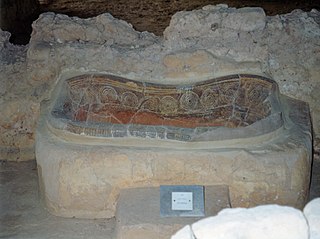
Aegean civilization is a general term for the Bronze Age civilizations of Greece around the Aegean Sea. There are three distinct but communicating and interacting geographic regions covered by this term: Crete, the Cyclades and the Greek mainland. Crete is associated with the Minoan civilization from the Early Bronze Age. The Cycladic civilization converges with the mainland during the Early Helladic ("Minyan") period and with Crete in the Middle Minoan period. From c. 1450 BC, the Greek Mycenaean civilization spreads to Crete, probably by military conquest.

Linear B is a syllabic script that was used for writing in Mycenaean Greek, the earliest attested form of the Greek language. The script predates the Greek alphabet by several centuries. The oldest Mycenaean writing dates to about 1400 BC. It is hypothesised to be descended from the older Linear A, an undeciphered earlier script potentially used for writing the Minoan language, as is the later Cypriot syllabary, which also recorded Greek. Linear B, found mainly in the palace archives at Knossos, Kydonia, Pylos, Thebes and Mycenae, disappeared with the fall of Mycenaean civilization during the Late Bronze Age collapse. The succeeding period, known as the Greek Dark Ages, provides no evidence of the use of writing.

Pylos, historically also known as Navarino, is a town and a former municipality in Messenia, Peloponnese, Greece. Since the 2011 local government reform, it has been part of the municipality Pylos-Nestoras, of which it is the seat and a municipal unit. It was the capital of the former Pylia Province. It is the main harbour on the Bay of Navarino. Nearby villages include Gialova, Pyla, Elaiofyto, Schinolakka, and Palaionero. The town of Pylos has 2,345 inhabitants, the municipal unit of Pylos 5,287 (2011). The municipal unit has an area of 143.911 km2.

The Minoan civilization was a Bronze Age culture which was centered on the island of Crete. Known for its monumental architecture and its energetic art, it is often regarded as the first civilization in Europe.
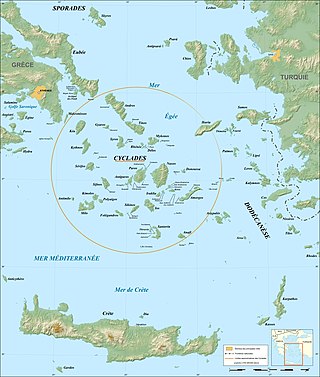
Cycladic culture was a Bronze Age culture found throughout the islands of the Cyclades in the Aegean Sea. In chronological terms, it is a relative dating system for artifacts which serves as a roughly contemporary dating system to Helladic chronology and Minoan chronology (Crete) during the same period of time.

Mycenaean Greece was the last phase of the Bronze Age in Ancient Greece, spanning the period from approximately 1750 to 1050 BC. It represents the first advanced and distinctively Greek civilization in mainland Greece with its palatial states, urban organization, works of art, and writing system. The Mycenaeans were mainland Greek peoples who were likely stimulated by their contact with insular Minoan Crete and other Mediterranean cultures to develop a more sophisticated sociopolitical culture of their own. The most prominent site was Mycenae, after which the culture of this era is named. Other centers of power that emerged included Pylos, Tiryns, and Midea in the Peloponnese, Orchomenos, Thebes, and Athens in Central Greece, and Iolcos in Thessaly. Mycenaean settlements also appeared in Epirus, Macedonia, on islands in the Aegean Sea, on the south-west coast of Asia Minor, and on Cyprus, while Mycenaean-influenced settlements appeared in the Levant and Italy.

The Treasury of Atreus or Tomb of Agamemnon is a large tholos or beehive tomb constructed between 1300 and 1250 BCE in Mycenae, Greece.
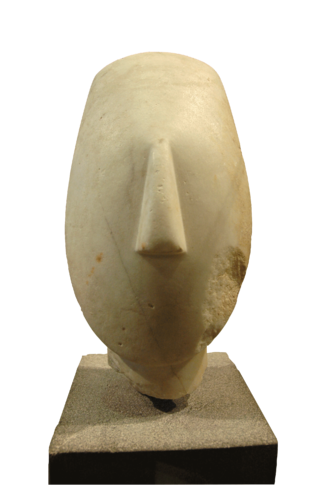
Aegean art is art that was created in the lands surrounding, and the islands within, the Aegean Sea during the Bronze Age, that is, until the 11th century BC, before Ancient Greek art. Because is it mostly found in the territory of modern Greece, it is sometimes called Greek Bronze Age art, though it includes not just the art of the Mycenaean Greeks, but also that of the non-Greek Cycladic and Minoan cultures, which converged over time.

Vaphio, Vafio or Vapheio is an ancient site in Laconia, Greece, on the right bank of the Eurotas, some 5 mi (8.0 km) south of Sparta. It is famous for its tholos or beehive tomb, excavated in 1889 by Christos Tsountas. This consists of a walled approach, about 97 ft (30 m) long, leading to a vaulted chamber some 33 ft (10 m) in diameter, in the floor of which the actual grave was cut. The tomb suffered considerable damage in the decades following its excavation. During conservation work in 1962 the walls were restored to a height of about 6 m (20 ft).

Minoan chronology is a measure of the phases of the Minoan civilization. Two systems of relative chronology are used for the Minoans. The first, based on pottery styles, divides Minoan history into three major periods: Early Minoan (EM), Middle Minoan (MM) and Late Minoan (LM). These periods can be divided using Roman numerals, which can be further divided using using capital letters. An alternative system, proposed by Greek archaeologist Nikolaos Platon, divides Minoan history into four periods termed Prepalatial, Protopalatial, Neopalatial, and Postpalatial. Though intended as a replacement for Evans's system, the two are generally used alongside one another.

Minoan religion was the religion of the Bronze Age Minoan civilization of Crete. In the absence of readable texts from most of the period, modern scholars have reconstructed it almost totally on the basis of archaeological evidence of such as Minoan paintings, statuettes, vessels for rituals and seals and rings. Minoan religion is considered to have been closely related to Near Eastern ancient religions, and its central deity is generally agreed to have been a goddess, although a number of deities are now generally thought to have been worshipped. Prominent Minoan sacred symbols include the bull and the horns of consecration, the labrys double-headed axe, and possibly the serpent.

Jack L. Davis is Carl W. Blegen Professor of Greek Archaeology at the University of Cincinnati in Ohio and is a former Director of the American School of Classical Studies at Athens.

Minoan seals are impression seals in the form of carved gemstones and similar pieces in metal, ivory and other materials produced in the Minoan civilization. They are an important part of Minoan art, and have been found in quantity at specific sites, for example in Knossos, Mallia and Phaistos. They were evidently used as a means of identifying documents and objects.
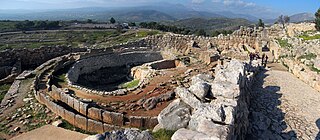
Grave Circle A is a 16th-century BC royal cemetery situated to the south of the Lion Gate, the main entrance of the Bronze Age citadel of Mycenae in southern Greece. This burial complex was initially constructed outside the walls of Mycenae and ultimately enclosed in the acropolis when the fortification was extended during the 13th century BC. Grave Circle A and Grave Circle B, the latter found outside the walls of Mycenae, represents one of the significant characteristics of the early phase of the Mycenaean civilization.
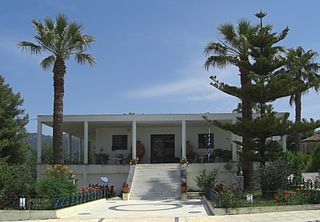
The Archaeological Museum of Chora is a museum in Chora, Messenia, in southern Greece, whose collections focus on the Mycenaean civilization, particularly from the excavations at the Palace of Nestor and other regions of Messenia. The museum was founded in 1969 by the Greek Archaeological Service under the auspices of the Ephorate of Antiquities of Olympia. At the time, the latter included in its jurisdiction the larger part of Messenia.

Marion Rawson was an American archaeologist. She is known for her work with Carl Blegen at Pylos in Greece and ancient Troy in modern Turkey. After her death, the University of Cincinnati established the Marion Rawson Professorship of Aegean Prehistory "in honor of her contributions to the field of Bronze Age Archaeology."

The Pylos Combat Agate is a Minoan sealstone of the Mycenaean era, likely manufactured in Late Minoan Crete. It depicts two warriors engaged in hand-to-hand combat, with a third warrior lying on the ground. It was discovered in the Griffin Warrior Tomb near the Palace of Nestor in Pylos and is dated to about 1450 BCE. The seal has come to be known as Pylos Combat Agate.
Sharon (Shari) Stocker is an American archaeologist who is best known, along with her husband, archaeologist Jack L. Davis, for leading an international team of researchers who discovered a previously undisturbed tomb of a Bronze Age warrior in southwest Greece. The 3500 year old intact grave was named the Griffin Warrior Tomb by the research team during the initial excavation in May 2015.
The archaeology of Greece includes artificial remains, geographical landscapes, architectural remains, and biofacts. The history of Greece as a country and region is believed to have begun roughly 1–2 million years ago when Homo erectus first colonized Europe. From the first colonization, Greek history follows a sequential pattern of development alike to the rest of Europe. Neolithic, Bronze, Iron and Classical Greece are highlights of the Greek archaeological record, with an array of archaeological finds relevant to these periods.














